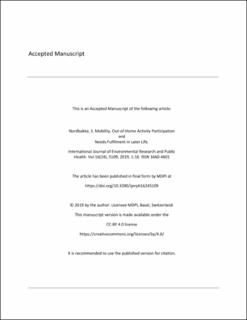| dc.contributor.author | Nordbakke, Susanne Therese Dale | |
| dc.coverage.spatial | Norway, Oslo | en_US |
| dc.date.accessioned | 2021-03-19T11:21:27Z | |
| dc.date.available | 2021-03-19T11:21:27Z | |
| dc.date.created | 2020-01-20T12:02:37Z | |
| dc.date.issued | 2019-12-14 | |
| dc.identifier.citation | International Journal of Environmental Research and Public Health. 2019, 16 (24), . | en_US |
| dc.identifier.issn | 1660-4601 | |
| dc.identifier.uri | https://hdl.handle.net/11250/2734445 | |
| dc.description.abstract | Using nationally representative survey of 4723 people aged 67 or older living in Norway, this paper explores the link between wellbeing, out-of-home activity participation and mobility in old age. A basic assumption of this paper is that out-home activities mediated through mobility can contribute to needs fulfillment, and, hence, wellbeing. This study explores the role of preferences, and individual and contextual constraints, in both the overall level of out-of-home activity participation in old age and the level of participation in three specific out-of-home activities (grocery shopping, visiting family or friends, and attending cultural activities). A person’s degree of home orientation is used as an indicator of preference for indoor activities. The findings suggest that age, living status, income, education, holding a driving license, health, social network, centrality of residence, and the quality of the public transport supply have a significant impact on the overall participation level. In addition, the study suggests that the types of constraints vary between travel purposes and the location of activities. Moreover, there is an independent effect of the degree of home orientation on the overall participation level, on the degree of visits to family and friends and on the degree of attending cultural activities, which suggest that people differ in their need for out-of-home activities. However, degree of home orientation has no impact on the degree of grocery shopping, which might imply that grocery shopping is more independent of preferences. The main conclusion from this study is that the extent to which out-of-home activities fulfill needs vary between individuals, depending on their preferences as well as the interplay between individual abilities and resources and contextual conditions. | en_US |
| dc.language.iso | eng | en_US |
| dc.publisher | MDPI | en_US |
| dc.rights | Navngivelse 4.0 Internasjonal | * |
| dc.rights | Navngivelse 4.0 Internasjonal | * |
| dc.rights.uri | http://creativecommons.org/licenses/by/4.0/deed.no | * |
| dc.title | Mobility, Out-of-Home Activity Participation and Needs Fulfilment in Later Life | en_US |
| dc.type | Journal article | en_US |
| dc.type | Peer reviewed | en_US |
| dc.rights.holder | This is an open access article distributed under the Creative Commons Attribution License which permits unrestricted use, distribution, and reproduction in any medium, provided the original work is properly cited. | en_US |
| dc.description.version | publishedVersion | en_US |
| cristin.unitcode | 7482,1,1,0 | |
| cristin.unitname | Reisevaner | |
| cristin.ispublished | true | |
| cristin.fulltext | original | |
| cristin.qualitycode | 1 | |
| dc.identifier.doi | 10.3390/ijerph16245109 | |
| dc.identifier.cristin | 1777539 | |
| dc.source.journal | International Journal of Environmental Research and Public Health | en_US |
| dc.source.volume | 16 | en_US |
| dc.source.issue | 24 | en_US |
| dc.source.pagenumber | 16 | en_US |
| dc.relation.project | Norges forskningsråd: 187780 | en_US |

